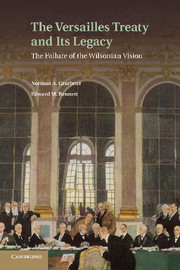Book contents
- Frontmatter
- Contents
- Preface
- 1 The International Order on Trial
- 2 The Road to Paris: 1917???1918
- 3 Versailles: A Study in Arrogance
- 4 The Retreat to Utopia
- 5 Manchuria and the Triumph of Non-Recognition
- 6 The Rise of Hitler
- 7 Challenge of the Dictators
- 8 The Elusive Response
- 9 Munich: The Continuing Escape from Reality
- 10 The Road to Prague
- 11 The Soviet Quest for Collective Security
- 12 The Coming of War: 1939
- Bibliography
- Index
- References
9 - Munich: The Continuing Escape from Reality
Published online by Cambridge University Press: 07 October 2011
- Frontmatter
- Contents
- Preface
- 1 The International Order on Trial
- 2 The Road to Paris: 1917???1918
- 3 Versailles: A Study in Arrogance
- 4 The Retreat to Utopia
- 5 Manchuria and the Triumph of Non-Recognition
- 6 The Rise of Hitler
- 7 Challenge of the Dictators
- 8 The Elusive Response
- 9 Munich: The Continuing Escape from Reality
- 10 The Road to Prague
- 11 The Soviet Quest for Collective Security
- 12 The Coming of War: 1939
- Bibliography
- Index
- References
Summary
I
Germany’s annexation of Austria did not fulfill Hitler’s territorial ambitions. In February 1938, the German leader advised Europe that he would protect the peoples of German origin “who were not in a position through their own efforts to obtain … for themselves the rights to … political and ideological freedom.” Following the Anschluss, Hitler’s irredentism marked Czechoslovakia’s Sudetenland, with its large, discontented German majority, as his next objective. The Paris Conference had established the Czech nation on the foundation of the old kingdom of Bohemia, but had added a motley collection of nationalities to round out its frontiers – Poles, Hungarians, Slovaks, Ruthenians, as well as Czechs and Germans. The Sudeten Germans dominated the narrow northern and western border between Czechoslovakia and Germany, as well as the Czech border with Austria in the south. For Czechoslovakia, this mountain frontier, with its strong fortifications, held a strategic importance that far transcended its size and population. The Sudetenland contained the bulk of Czechoslovakia’s natural resources and heavy industry, including the famed Skoda munitions works. Equally troubling, the Anschluss demonstrated the diminution of Anglo-French power to sustain what remained of the Versailles settlement.
- Type
- Chapter
- Information
- The Versailles Treaty and its LegacyThe Failure of the Wilsonian Vision, pp. 166 - 187Publisher: Cambridge University PressPrint publication year: 2011

